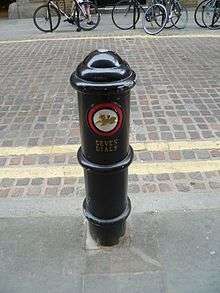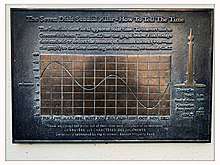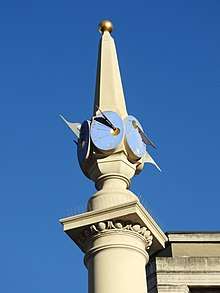Seven Dials, London
Seven Dials is a road junction in the St Giles district of the London Borough of Camden, close to Covent Garden in the West End of London. Seven streets converge at the roughly circular junction, at the centre of which is a column bearing six sundials – the column had been commissioned before a late-stage alteration of the plans from an original six roads to seven.
.jpg)
The term also refers informally to the area immediately surrounding.
History

The landed estate formally belonged to the Worshipful Company of Mercers which allowed building licences on what was open farmland to maximise their income in the burgeoning West End of the developing metropolitan area. The original layout of the Seven Dials area was designed by Thomas Neale during the early 1690s. The original plan had six roads converging, although this was later increased to seven. The sundial column was built with only six faces, with the column itself acting as the gnomon of the seventh dial. This layout was chosen to produce triangular plots, in order to maximise the frontage of houses to be built on the site, as rentals were charged per foot of frontage rather than by the square footage of properties.[1]
After the successful development of the Covent Garden Piazza area nearby, Neale hoped that Seven Dials would be popular with wealthy residents. This was not to be and the area gradually deteriorated. At one stage, each of the seven apexes facing the column housed a pub. By the 19th century, Seven Dials was among the most notorious slums in London, as part of the slum of St Giles. The area was described by Charles Dickens during 1835:[2]
... streets and courts [that] dart in all directions, until they are lost in the unwholesome vapour which hangs over the house-tops and renders the dirty perspective uncertain and confined.
In his collection Sketches by Boz, Dickens remarks,[1]
The stranger who finds himself in the Dials for the first time...at the entrance of Seven obscure passages, uncertain which to take, will see enough around him to keep his curiosity awake for no inconsiderable time...
The poet John Keats described the area as the last resort for the poor and the ill.[3]
... where misery clings to misery for a little warmth, and want and disease lie down side-by-side, and groan together.
The relatively low status of the location is also stated by W. S. Gilbert in the operetta Iolanthe
Hearts just as pure and fair
May beat in Belgrave Square
As in the lowly air of Seven Dials.
It remained a byword for urban poverty during the early 20th century, when Agatha Christie set The Seven Dials Mystery (1929) there.
The original sundial column was removed during 1773. It was long believed that it had been pulled down by an angry mob, but recent research suggests it was deliberately removed by the Paving Commissioners in an attempt to rid the area of "undesirables". The remains were acquired by architect James Paine, who kept them at his house in Addlestone, Surrey, from where they were bought during 1820 by public subscription and re-erected in nearby Weybridge as a memorial to Princess Frederica Charlotte of Prussia, Duchess of York and Albany.
During the 1840s Seven Dials was a major gathering area for the Chartists in their campaign for electoral reform. However, the intended uprisings there were thwarted by police infiltrators.[4]
By 1851 sewers were laid in the area but poverty intensified in St Giles and in the Seven Dials although the population began to decrease as workshops and breweries began occupying some of the houses.[5] The model established here for supporting poor children in education developed by Margaret Frere was to be a model adopted throughout London for School social work.[6]
The seven streets at Seven Dials originally had quite different names from what they have now. They were Great Earl Street, Little Earl Street, Great White Lion Street, Little White Lion Street, Great St Andrew's Street, Little St Andrew's Street and Queen Street.[7] In the 1930s, their names were changed: Great and Little Earl Streets became Earlham Street, Great and Little White Lion Streets became part of an extended Mercer Street, Great and Little St Andrew's Streets became Monmouth Street, and Queen Street became Shorts Gardens.
Today, only two houses remain from the original Thomas Neale development of the 1690s; 61 Monmouth Street and 64 Neal Street.
Seven Dials, 1974 to 2018

According to Camden Council, the currently defined area "can be found to the north west of Covent Garden Market, and just to the south of Shaftesbury Avenue. The Dials comprise Earlham Street, Monmouth Street, Mercer Street and Shorts Gardens. The area now known as Seven Dials also includes Neal Street and Neals Yard."[8] Monmouth Street is the only street in Seven Dials to have an official number; the B404. The others are unclassified.
During 1974, Seven Dials was named a Conservation Area with Outstanding Status[9] and during 1977 it was declared a Housing Action Area. By 1984, the Housing Action Area Committee ensured that all of the vacant homes were in some use and was encouraging business to locate in the area.[10][11] An increasing number of buildings have been restored over the years. Since 1974, over 25 percent of the area's buildings have been listed.[12] Presently Seven Dials is a prosperous, largely commercial neighbourhood in the WC2 postcode area between the West End theatre district of Shaftesbury Avenue and the fashionable shopping district around nearby Neal's Yard. It is dominated by generally slow-moving traffic in the narrow streets, which are usually crowded with people.
The replacement sundial pillar, commissioned by The Seven Dials Trust, (formerly The Seven Dials Monument Charity),[13] was constructed during 1988–89 to the original design. It was unveiled by Beatrix of the Netherlands during June 1989, on a visit to commemorate the tercentenary of the reign of William III and Mary II, during which the area was developed. The monument is owned by, and continues to be maintained by, The Seven Dials Trust whose mandate also includes improving the area, working with landowners as well as national and local agencies.[9][12]
By late 2017, investment company Shaftesbury plc owned an increasing number of the buildings, a "huge chunk" of the area, according to one news report.[14] At that time, significant changes were occurring in the business properties including the conversion of a mall owned by Shaftesbury plc, Thomas Neal's Warehouse, into a single store that might become the main store for a major retailer and the conversion of a warehouse into office space.[15]
On one of the seven apexes remains a pub, The Crown. On another apex is the Cambridge Theatre, and on a third the Radisson Edwardian Mercer Street Hotel. On another is the Comyn Ching Triangle, a block of old buildings renovated during the 1980s. Despite some redevelopment, many original buildings remain. There are two historic plaques in the area, one at 13 Monmouth Street, where Brian Epstein managed his company[1] and another in Neal's Yard, at the "Animation, Editing and Recording Studios of Monty Python", actually the studios and offices of Michael Palin and Terry Gilliam from 1976 to 1987.[16]
A November 2017 report describes Seven Dials as follows:
In its own right, this septet of streets is home to nearly 100 fashion, beauty and lifestyle stores, plus 90 or so independent cafés, bars and restaurants. You can find food, fashion and music festivals throughout the year, join in huge parades or private shopping events, and there is culture galore on tap, including many of the West End's best known theatres on the doorstep. ... Seven Dials combines boutique, independent retail with high-end, household name British brands, street food with Michelin-starred restaurants, and cutting edge coolness with a definite flavour of its past in its cobbled streets and courtyards.
The monument

Neale commissioned the architect and stonemason Edward Pierce to design and construct a sundial pillar during 1693–94. The original drawing in brown ink with a grey wash is in the British Museum collection.[17]
On top of an 8 feet (2.4 m) high plinth, there is a 20 feet (6.1 m) high Doric column. The sculpture that contains the six sundials and the pinnacle is 10 feet (3.0 m). This block is arranged with a directly southern and direct northern vertical dial, and four vertically declining dials. The monument was erected during 1694, but removed during 1773.[18] The replica was commissioned during 1984 and erected during 1989 The dials were designed, carved and gilded by Caroline Webb, while the astronomer Gordon Taylor verified the maths. Each of the faces is accurate to within ten seconds.[18] The dials give local apparent solar time, so a correction must be made using the conversion graph displayed on the plinth to work out clock time.[18] Seven dials is 0° 07' geographical degrees to the west of Greenwich – that is 3.048 seconds behind Greenwich Mean Time.
In popular culture

- "The Monmouth Street Cap", an 1819 poem by Elizabeth Beverley, is a satirical account of public charity.[19]
- One of the pieces in Charles Dickens' collection Sketches by Boz (1837–1839) is named "Seven Dials".[20]
- In H. G. Wells' 1897 short story "The Crystal Egg", the eponymous object is owned by the proprietor of "a little and very grimy-looking shop near Seven Dials." [21]
- Agatha Christie's 1929 work, The Seven Dials Mystery. In 1981, London Weekend Television televised an adaptation of the book, with well-known actors, including John Gielgud.[22]
- C. S. Forester's novel Mr. Midshipman Hornblower (1950) features a duchess, in the chapter "The Duchess and the Devil", who speaks in a "startlingly vulgar" accent from the Seven Dials.
- The name of the police station in the British television series The Gentle Touch (1980–1984) was Seven Dials.[23]
- "I could be a rambler from the Seven Dials" is the opening lyric of Stephen Stills's 1991 song "Treetop Flyer".[24]
- Several episodes of the 2008 British television series City of Vice are set around Seven Dials.[25]
- Slammerkin, a 2000 novel by Emma Donoghue, is partly set in Seven Dials.[26]
- In Terry Pratchett's 2012 novel Dodger, Seven Dials is the setting for much of the action and where the eponymous hero lives.[27]
- The Bone Season, a 2013 novel by Samantha Shannon, is partly set in Seven Dials.[28]
- Roddy Frame's fourth solo studio album, released in 2014, is entitled Seven Dials. Frame explained in a radio interview that he has spent much time there.[29][30]
- Brenda Hiatt's five-book Regency romance Saint of Seven Dials series features rogue heroes who rob from the rich to help the poor in the notorious Seven Dials slum of Regency era London.[31][32]
- The 23rd book (2003) in Anne Perry's historical fiction series featuring Charlotte & Thomas Pitt, set in the late 1800s, is titled Seven Dials. A part of the book takes place in that slum area.[33]
- The final book in the Williamson Papers series, Back Home by Tom Williams, is also set in 19th-century London; a character has gotten into trouble in the Seven Dials.[34]
Property development
Seven Dials is predominantly owned by Shaftesbury PLC, which also have a joint venture with the Worshipful Company of Mercers at the adjoining St Martin's Courtyard.[35]
References
- Anon. "A History of Covent Garden's Hidden Shopping Village". www.sevendials.co.uk. Retrieved 7 June 2019.
- Rebecca Dalzell (5 June 2011). "How Charles Dickens Saw London". Smithsonian. Retrieved 27 February 2020.
- "Seven Dials, a London slum". Victorianweb.org. 11 May 2017. Retrieved 20 March 2019.
- Flett, Keith. "16th August 1848- the last attempted armed rising on English soil?". Retrieved 16 August 2013.
- "History". St Giles. Retrieved 20 March 2019.
- "Frere, Margaret (1863–1961), welfare worker". Oxford Dictionary of National Biography. doi:10.1093/ref:odnb/75205. Retrieved 5 August 2020.
- Weinreb, Ben; Hibbert, Christopher (1992). The London Encyclopaedia (reprint ed.). Macmillan. p. 801.
- Seven Dials renaissance lifts historic London street to rival great European cities Camden Council, 1 January 2006 Archived 7 July 2018 at the Wayback Machine
- "Seven Dials History Plaque - The Seven Dials Trust, Covent Garden, London". Sevendials.com. Retrieved 20 March 2019.
- "The Seven Dials Trust (formerly the 'Seven Dials Monument Charity')". Sevendials.com. Retrieved 20 March 2019.
- "The Seven Dials Trust (formerly the 'Seven Dials Monument Charity')". Sevendials.com. 26 March 1999. Retrieved 20 March 2019.
- "London - Places - The rise and fall... And rise again of Seven Dials". BBC. 13 November 2014. Retrieved 20 March 2019.
- "Seven Dials Public Realm Strategy Report" (PDF). Covent Garden. Retrieved 20 March 2019.
- Property investment firm now owns huge chunk Seven Dials City AM Archived 7 July 2018 at the Wayback Machine
- "Shaftesbury converts Seven Dials mall into flagship store". Nash Bond. 1 September 2017. Retrieved 20 March 2019.
- "Monty Python : London Remembers, Aiming to capture all memorials in London". Londonremembers.com. Retrieved 20 March 2019.
- British Museum Accession Number 1881,0611.177
- de Clercq, Peter (25 February 2013). "The sundial column at Seven Dials | The Story of Time". blog.ahsoc.org. Antiquarian Horological Society. Retrieved 26 March 2017.
- British Library Main Catalogue. Retrieved 21 April 2015.
- Dickens, Charles. "Chapter 5 – Scenes". Sketches by Boz, Illustrative of Every-Day Life and Every-Day People by Dickens. Gutenberg. Retrieved 27 March 2017.
- "The Crystal Egg". The Literature Network.
- Bunson, Matthew (2000). "The Complete Christie: An Agatha Christie Encyclopedia". Gallery. p. 421. ISBN 978-0671028312.
- "BFI Screenonline: Gentle Touch, The (1980–84)". www.screenonline.org.uk. Retrieved 27 March 2017.
- "Stephen Stills – Treetop Flyer Lyrics | MetroLyrics". www.metrolyrics.com. Retrieved 27 March 2017.
- "City of Vice – Episode Guide – All 4". www.channel4.com. Retrieved 27 March 2017.
- Donoghue, Emma (2011). Slammerkin. Virago. ISBN 9780748133444. Retrieved 2 August 2017.
- Pratchett, Terry (28 January 2014). "Dodger's Guide to London: Based on Original Notes Penned by Jack Dodger Himself". Amazon. Doubleday UK. Retrieved 27 March 2017.
- "The Bone Season (The Bone Season, #1)". Goodreads. Retrieved 27 March 2017.
- Roddy Frame (2 May 2014). "Artist Playlist—Roddy Frame's 'songs with a sense of place'". Q Magazine. Bauer Consumer Media. Retrieved 8 May 2014.
- "Roddy Frame live in session for Sir Terry Wogan" (Audio upload). Weekend Wogan. BBC. 2 June 2014. Retrieved 21 June 2014.
- Hiatt, Brenda (20 October 2011). "Rogue's Honor". Amazon. Dolphin Star Press. Retrieved 27 March 2017.
- "BFI Screenonline: Gentle Touch, The (1980-84)". www.screenonline.org.uk. Retrieved 27 March 2017.
- "Fiction Book Review: SEVEN DIALS by Anne Perry, Author . Ballantine $25.95 (352p) ISBN 978-0-345-44007-5". Publishersweekly.com. 6 January 2003. Retrieved 20 March 2019.
- Tom Williams. "Back Home by Tom Williams". Goodreads.com. Retrieved 20 March 2019.
- "Shaftesbury—History". www.shaftesbury.co.uk. Archived from the original on 24 July 2010. Retrieved 5 August 2010.
External links
| Wikimedia Commons has media related to Seven Dials, London. |